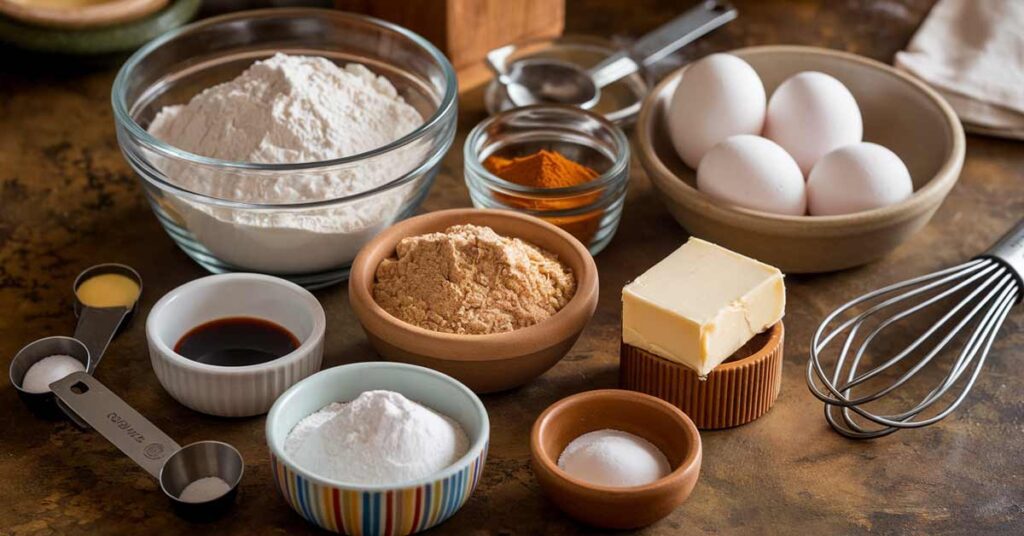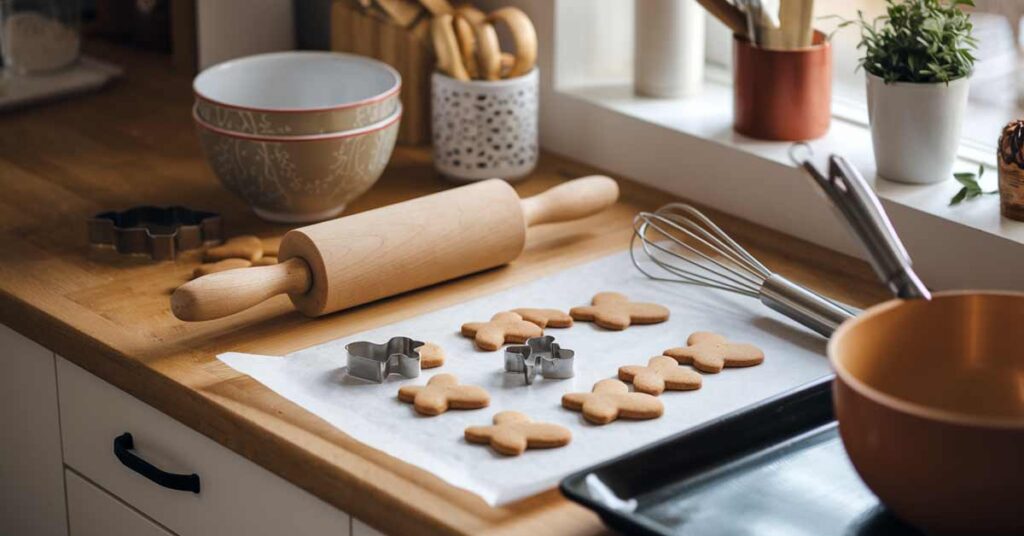
Table of Contents
ToggleHow to Make the Best Classic Gingerbread Cookies for Valentine’s Day
This classic gingerbread cookie recipe is the easiest way to make Valentine’s Day unforgettable!
There’s nothing quite like the warm, spiced smell of gingerbread cookies filling your kitchen, especially when they’re heart-shaped and decorated with love.
With simple ingredients and step-by-step instructions, you’ll have these chewy, flavour-packed cookies ready to share—or keep for yourself!
For more Valentine cookie ideas to make your treats extra special, check out our classic Valentine’s cookies guide for inspiration and decorating tips.
Ingredients To Make Perfect Traditional Gingerbread Cookies

To make this classic gingerbread cookie recipe, we’ll keep it simple with ingredients you likely have at home. Each ingredient is listed in the order it’s used, and I’ve included both metric and imperial measurements to make it easy to follow along, no matter where you’re baking.
Ingredients Table
| Ingredient | Metric | Imperial | Notes |
|---|---|---|---|
| Plain flour | 250 g | 2 cups | Sifted, for a lighter texture |
| Ground ginger | 1 tbsp | 1 tbsp | Adds the signature gingerbread warmth |
| Ground cinnamon | 1 tsp | 1 tsp | Optional, but enhances the flavour |
| Ground nutmeg | ½ tsp | ½ tsp | Optional, for extra spice depth |
| Baking powder | 1 tsp | 1 tsp | Helps the cookies rise slightly |
| Salt | ½ tsp | ½ tsp | Balances the sweetness |
| Unsalted butter | 125 g | ½ cup | Softened to room temperature |
| Brown sugar | 100 g | ½ cup | Adds a rich, molasses-like flavour |
| Golden syrup or molasses | 60 ml | ¼ cup | Molasses gives a traditional taste |
| Large egg | 1 | 1 | Binds the ingredients and adds moisture |
| Vanilla extract | 1 tsp | 1 tsp | For an extra hint of sweetness and aroma |
Ingredient Notes
- Flour: Sifting the flour creates a smoother dough and helps prevent lumps.
- Spices: Ground ginger is essential for that classic gingerbread taste, but adding cinnamon and nutmeg brings out extra warmth and complexity. Adjust the spices to suit your taste!
- Golden Syrup/Molasses: Molasses is traditional for gingerbread, but golden syrup will work if it’s more accessible. Molasses gives a richer, darker flavour.
- Butter: For best results, let your butter soften at room temperature before starting. This helps create a soft, chewy texture.
- Egg: One egg is all you need to bind the ingredients and add a little moisture.
This organised ingredients list will set you up for success and make the recipe easy to follow. Each item has been chosen for a reason, so don’t skip any if you’re looking for that perfect classic gingerbread taste! Let me know if you’d like to add more details.
Perfect Gingerbread Cookie Measurements: Tips for Precision and Success
For the best results with this classic gingerbread cookie recipe, measuring accurately is key. Since baking is a precise science, even small measurement variations can affect your cookies’ texture, taste, and appearance. That’s why I’ve provided both weight (metric) and volume (imperial) measurements, so you can use the method you’re most comfortable with.
Why Accurate Measurements Matter
Using accurate measurements helps ensure your cookies turn out exactly as intended. For example, a little extra flour might make the dough too tough to roll, while too little can make the cookies spread too thinly. By offering both metric (grams, millilitres) and imperial (cups, tablespoons) measurements, I’ve made sure this recipe is accessible and easy to follow, no matter where you are or what equipment you have on hand.
Quick Conversion Guide
To make things even easier, here’s a guide to some common conversions:
| Measurement | Metric | Imperial |
|---|---|---|
| 1 cup flour | 125 g | 1 cup |
| 1 tablespoon | 15 ml | 1 tbsp |
| 1 teaspoon | 5 ml | 1 tsp |
| ½ cup butter | 125 g | ½ cup (1 stick) |
| ¼ cup syrup | 60 ml | ¼ cup |
Visual Aid (Optional)
If you’re new to baking or just want a quick reference, here’s a helpful tip:
- Tablespoons and Teaspoons: Remember, a tablespoon is three times larger than a teaspoon. Using the right measuring spoon is important for spices like ginger and cinnamon, as they add a lot of flavour even in small amounts.
- Cup Measurements: Make sure to level off ingredients like flour with a flat edge for an exact measure; heaping the flour could throw off the texture of your cookies.
- Weight vs. Volume: For the most accuracy, use a digital scale for ingredients like flour and butter. Weight measurements are generally more precise than volume, especially with flour, which can vary depending on how tightly it’s packed.
Accurate measurements will help you nail this recipe every time, and it’s worth a little extra care to get that perfect classic gingerbread cookie!
Ingredient Substitutions for a Perfect Classic Gingerbread Cookie
Sometimes you might not have every ingredient on hand, or you might want to adapt the recipe to suit dietary preferences. Here are some easy substitutions that still deliver on flavour and texture, keeping this classic gingerbread cookie recipe as delicious as ever.
1. Molasses Substitute
Golden Syrup or Honey: If molasses isn’t available, golden syrup or honey can be used as a substitute. Both provide sweetness and a similar sticky texture, though they’ll result in a slightly lighter flavour. Molasses is traditional in gingerbread and adds a rich, deep taste, so if you want that classic flavour, it’s the preferred choice.
Dark Corn Syrup: This can be a close replacement for molasses, especially for those who want a slightly less intense taste while keeping a similar consistency.
2. Brown Sugar Substitute
White Sugar: In a pinch, white granulated sugar can be used instead of brown sugar. However, note that brown sugar has molasses in it, which adds a rich, almost caramel-like flavour. If using white sugar, your cookies may have a milder taste and slightly crispier texture.
Coconut Sugar: For a less processed option, try coconut sugar. It has a similar depth of flavour to brown sugar but is lower on the glycaemic index, making it a popular choice for those watching their sugar intake.
3. Butter Alternative
Margarine: Margarine works as a straightforward butter substitute and will yield a similar texture and taste, though the flavour may be slightly different. Ensure you’re using an unsalted variety for best results.
Vegan Butter or Coconut Oil: For a dairy-free or vegan version, use vegan butter or coconut oil. Vegan butter offers a close match to traditional butter, while coconut oil can add a hint of coconut flavour that pairs well with the spices in gingerbread. Just remember that coconut oil may make the cookies slightly crisper.
4. Gluten-Free Flour Alternative
Gluten-Free Flour Blend: Swap regular flour with a 1:1 gluten-free baking blend, which often includes rice flour, potato starch, and xanthan gum. This type of blend is designed to mimic regular flour’s properties, making it an ideal option for a soft, chewy gingerbread cookie that’s gluten-free.
Almond Flour: Almond flour can also be used, but it will produce a denser, more crumbly cookie with a slightly nutty flavour. If choosing almond flour, you may need to adjust other ingredients, such as adding an extra egg to help bind the dough.
5. Egg Substitute
Flaxseed or Chia Seed “Egg”: For an egg-free recipe, mix 1 tablespoon of ground flaxseed or chia seed with 3 tablespoons of water, then let it sit for a few minutes to form a gel. This mixture can replace one egg and works well to bind ingredients in a cookie recipe, though the cookies may be a bit denser.
These substitutions allow you to customise your classic gingerbread cookies while maintaining flavour and texture. Whether you’re catering to dietary needs or just making do with what’s in the pantry, these tips will keep your gingerbread cookies tasting fantastic!
Nutrition Facts for Gingerbread Cookies
Knowing the nutritional content of your cookies can be helpful, whether you’re mindful of your intake or simply curious. Here’s a general nutrition breakdown per serving. These values are approximate and based on one standard-sized cookie, with a typical batch making around 24 cookies.
Nutrition Facts Table (per cookie)
| Nutrient | Amount per Cookie | % Daily Value* |
|---|---|---|
| Calories | 120 kcal | – |
| Total Fat | 4 g | 5% |
| Saturated Fat | 2 g | 10% |
| Cholesterol | 10 mg | 3% |
| Sodium | 50 mg | 2% |
| Total Carbohydrates | 19 g | 7% |
| Dietary Fiber | 1 g | 4% |
| Sugars | 10 g | – |
| Protein | 1 g | 2% |
| Calcium | 10 mg | 1% |
| Iron | 0.5 mg | 3% |
Nutritional Highlights
- Calories: These classic gingerbread cookies contain around 120 calories per cookie, making them a moderate treat.
- Fat: With 4 grams of fat, including 2 grams of saturated fat, these cookies are rich enough to satisfy but not overly indulgent.
- Carbohydrates: Each cookie contains about 19 grams of carbohydrates, primarily from flour and sugar. These give gingerbread its signature texture and sweetness.
- Sugars: With 10 grams of sugar per cookie, this recipe provides a balanced sweetness, thanks to brown sugar and molasses.
- Fiber and Protein: While not high in fiber or protein, these cookies still offer around 1 gram each, adding a slight nutritional boost.
- Vitamins and Minerals: Gingerbread cookies contain small amounts of calcium and iron, mostly from molasses, which is a natural source of minerals.
Notes on Serving Size and Dietary Adjustments
- Serving Size: Adjust the serving size to fit your batch. If you make smaller cookies, the calorie count and other values per serving will naturally decrease. For larger cookies, these values will be slightly higher.
- Dietary Adjustments: Substituting ingredients (such as using coconut oil instead of butter or a gluten-free flour blend) may slightly alter the nutritional values, especially in fat content and carbohydrates.
These nutrition facts help you enjoy your classic gingerbread cookies mindfully. With a moderate calorie count and balanced macronutrients, they’re perfect for a holiday treat without going overboard!
Recommended Equipment To Make Gingerbread Cookies

Using the right tools makes a big difference when baking gingerbread cookies. Here’s a list of the essential equipment you’ll need, along with tips on how each item helps you achieve perfect cookies.
1. Mixing Bowls
Purpose: Mixing bowls are essential for combining your dry and wet ingredients separately before mixing them together. This helps to ensure that ingredients like baking powder and spices are evenly distributed.
Tip: Use a medium bowl for dry ingredients and a large bowl for wet ingredients, allowing enough space for easy mixing without spills.
2. Electric Mixer or Hand Mixer
Purpose: While you can mix by hand, an electric mixer (hand-held or stand mixer) makes it much easier to cream butter and sugar, which is crucial for achieving a smooth dough.
- Tip: Start at a low speed to avoid ingredients splattering, then gradually increase the speed for a creamy, well-blended texture.
3. Rolling Pin
Purpose: A rolling pin is used to roll out the gingerbread dough to an even thickness, which is important for uniform baking. A good rolling pin helps you achieve a smooth, consistent dough without overworking it.
Tip: Lightly flour your rolling pin and work surface to prevent the dough from sticking. If the dough gets too soft, pop it back in the fridge for a few minutes.
4. Cookie Cutters
Purpose: Cookie cutters let you shape your gingerbread into festive designs. For a Valentine’s Day theme, heart-shaped cutters are perfect, but you can use any shape you like.
Tip: Dip the cutters lightly in flour before each cut to prevent sticking, and press firmly for clean, defined edges.
5. Baking Sheet and Parchment Paper
Purpose: A baking sheet is essential for baking your cookies evenly. Lining it with parchment paper prevents sticking and makes cleanup a breeze.
Tip: Leave some space between cookies on the sheet to allow for slight spreading during baking. Using a rimmed baking sheet also helps prevent any spills.
6. Cooling Rack
Purpose: A cooling rack allows air to circulate around the cookies after baking, helping them cool evenly and preventing sogginess.
Tip: Let cookies sit on the baking sheet for a minute or two after they come out of the oven, then transfer to the cooling rack to finish cooling. This helps them firm up and avoid breaking.
7. Spatula
Purpose: A flat spatula is perfect for transferring your cut-out dough onto the baking sheet and for moving baked cookies from the sheet to the cooling rack without breaking them.
Tip: For best results, use a thin metal spatula to lift cookies without disturbing their shape.
Optional Equipment for Decorating
Icing Bags and Tips: If you’d like to decorate your gingerbread cookies, icing bags and small piping tips are useful for adding fine details. For Valentine’s Day, consider using red, white, and pink icing to add a romantic touch.
Sprinkle Shakers: Sprinkle shakers make it easy to add decorative sugar or sprinkles to your cookies without overdoing it.
Using these tools will make the gingerbread cookie baking process smoother, and having them on hand helps ensure that each step is as straightforward and mess-free as possible.
Method (Step-by-Step Instructions) To Bake Gingerbread Cookies
Follow these simple steps to make your classic gingerbread cookies. These instructions ensure each step is easy to follow, helping you create perfectly soft and flavourful cookies with a festive Valentine’s Day twist.
- Preheat the Oven: Set your oven to 180°C (350°F), allowing it to fully preheat while you prepare the dough. A well-preheated oven helps the cookies bake evenly.
- Combine Dry Ingredients: In a medium mixing bowl, whisk together the flour, ground ginger, baking powder, cinnamon (if using), nutmeg, and salt. Whisking incorporates the ingredients evenly, so each cookie has a balanced spice flavour.
- Cream Butter and Sugar: In a separate large bowl, use an electric mixer (or hand whisk) to cream the softened butter and brown sugar until the mixture is light and fluffy. This process takes about 2–3 minutes. Creaming helps incorporate air into the dough, giving the cookies a slightly lighter texture.
- Add Golden Syrup or Molasses: Gradually pour in the golden syrup or molasses, mixing until it’s fully combined with the butter and sugar mixture. This step adds moisture and richness to the dough, giving the cookies their classic chewy texture and deep flavour.
- Mix in the Egg and Vanilla Extract: Crack in the egg and add the vanilla extract, mixing until smooth. The egg acts as a binder, helping to hold the dough together, while the vanilla enhances the sweetness and adds depth to the flavour.
- Form the Dough: Gradually add the dry ingredients to the wet ingredients, mixing on low speed (or by hand with a wooden spoon) until everything is combined and forms a soft, slightly sticky dough. Avoid overmixing, as this can make the cookies tough.
- Chill the Dough: Wrap the dough tightly in cling film and refrigerate for at least 30 minutes. Chilling firms up the dough, making it easier to roll and cut. It also prevents the cookies from spreading too much in the oven, helping them keep their shape.
- Roll Out the Dough: Lightly flour your work surface and rolling pin, then roll the chilled dough to about ¼-inch (0.6 cm) thickness. This thickness provides the perfect balance between soft and crispy textures. If the dough becomes too soft while rolling, pop it back in the fridge for a few minutes.
- Cut Out Cookie Shapes: Use heart-shaped cookie cutters to cut out the cookies, pressing down firmly to ensure clean edges. Re-roll any leftover dough and continue cutting until all dough is used. For best results, dip the cookie cutters in flour to prevent sticking.
- Place on Baking Sheet: Line a baking sheet with parchment paper and arrange the cookies about 1 inch apart. The parchment paper prevents sticking and ensures an even bake.
- Bake: Place the baking sheet in the preheated oven and bake for 8–10 minutes. The cookies are done when the edges start to turn a light golden colour. Avoid overbaking, as this can make them too crispy—classic gingerbread cookies are meant to be soft and slightly chewy.
- Cool the Cookies: Remove the cookies from the oven and let them sit on the baking sheet for a minute or two. Then transfer them to a wire cooling rack to cool completely. This step helps the cookies firm up without becoming too crisp.
- Decorate as Desired: Once cooled, the cookies are ready to be decorated. For a festive Valentine’s Day look, try using royal icing, chocolate drizzle, or red and pink sprinkles. If using icing, let it dry completely before stacking or serving.
Following these step-by-step instructions will help you achieve perfect classic gingerbread cookies with a Valentine’s Day twist.
Decorating Your Classic Gingerbread Cookies

Adding decorative touches to your gingerbread cookies is a fun way to make them truly special for Valentine’s Day. Whether you’re going for a romantic, festive, or playful look, decorating gives these cookies a personal touch that’s sure to impress.
1. Royal Icing Designs
Piping Hearts and Patterns: Use royal icing to pipe heart shapes, swirls, and patterns onto each cookie. To create a two-tone look, try using both red and pink icing. Allow the icing to dry completely for a smooth, glossy finish.
Outline and Flood: For a professional look, outline the cookie’s edge with a piping bag, then “flood” the centre with thinner icing to create a smooth, even layer. Use toothpicks to spread the icing and pop any air bubbles.
2. Chocolate Drizzle and Dipping
Drizzling for Elegance: Melt dark, milk, or white chocolate and use a spoon to drizzle it over your cookies in a zigzag pattern. For Valentine’s Day, white chocolate tinted with a drop of red food colouring creates a beautiful pink drizzle.
Dipping for Contrast: Dip half of each cookie in melted chocolate for a classy two-tone effect. Sprinkle the chocolate half with edible glitter or sprinkles before it sets for an extra festive touch.
3. Edible Glitter and Sprinkles
Adding Sparkle: Edible glitter adds a touch of luxury to your cookies. Dust it lightly over the icing or chocolate to catch the light and give each cookie a little sparkle.
Valentine’s Day Sprinkles: Red, pink, and heart-shaped sprinkles are perfect for the occasion. Add them to wet icing or chocolate to help them stick.
4. Custom Messages
Personalised Notes: Use a fine piping tip and royal icing to write short, sweet messages on each cookie, like “Love,” “Be Mine,” or “XO.” This adds a heartfelt, personal touch that makes these treats even more special.
For more cookie decorating ideas that will inspire you this Valentine’s Day, check out our full guide on cookie decorating ideas. This guide has more tips, techniques, and designs to take your cookies to the next level.
FAQs About Classic Gingerbread Cookies
Curious about how to get the perfect gingerbread cookies or make the recipe more flexible? Here are answers to some of the most commonly asked questions about baking and decorating gingerbread cookies.
1. Why Chill the Dough?
Chilling the dough is an essential step. It allows the dough to firm up, making it easier to roll and cut into shapes without sticking. Chilling also helps prevent the cookies from spreading too much during baking, ensuring that they hold their shape and come out with crisp, clean edges.
2. Can I Make the Dough in Advance?
Yes, you can prepare the dough in advance. Simply wrap it tightly in cling film or store it in an airtight container, then refrigerate for up to 2 days. When you’re ready to bake, let the dough sit at room temperature for a few minutes to soften slightly, making it easier to roll out.
3. Can I Freeze These Cookies?
Absolutely! Baked gingerbread cookies can be stored in an airtight container and frozen for up to 3 months. To thaw, simply leave them out at room temperature for a few hours. You can also freeze the unbaked dough for up to 3 months; just let it thaw overnight in the fridge before rolling and baking.
4. What’s the Best Way to Decorate for Valentine’s Day?
To give your gingerbread cookies a romantic touch for Valentine’s Day, try using pink or red royal icing, edible glitter, or a chocolate drizzle. You can even add heart-shaped sprinkles or write sweet messages with icing for a personalised effect.
5. Should Gingerbread Cookies Be Hard or Soft?
This depends on personal preference. Classic gingerbread cookies are typically on the softer side, with a chewy texture, especially if you don’t overbake them. However, if you prefer a crispier cookie, simply bake them for a few extra minutes or roll the dough slightly thinner.
6. What is the Difference Between Gingerbread and Ginger Cookies?
While both are spiced treats, gingerbread cookies and ginger cookies differ in texture and taste. Gingerbread cookies are typically softer, more cake-like, and often shaped or decorated, especially for holidays. Ginger cookies, on the other hand, are usually round, thinner, and tend to be crisper with a pronounced ginger flavour.
7. Which Molasses is Best for Gingerbread Cookies?
Unsulphured molasses is the best choice for gingerbread cookies, as it has a rich, deep flavour without the bitterness of blackstrap molasses. This type of molasses is less processed and has a smooth sweetness that complements the spices in gingerbread.
8. Can You Use Honey Instead of Golden Syrup in Gingerbread?
Yes, honey can be used as a substitute for golden syrup in gingerbread cookies. While honey has a distinct flavour that will slightly alter the taste, it adds a similar sweetness and moisture. Keep in mind that honey is sweeter than golden syrup, so you may wish to reduce the sugar slightly if you prefer a milder sweetness.
Previous Article
The Ultimate Classic Vanilla Cookie Recipe – Perfectly Sweet and Simple
Next Article
The Best Red Velvet Cookie Recipe for a Sweet Treat
Related Posts
- First Date Questions: Master the Art of Conversation on Your Next Date
- Transform Your Kitchen with Romantic Valentine’s Day Table Decor Ideas
- Sophisticated Valentine’s Day Decor Ideas to Elevate Your Celebration
- Date Ideas That Start with G: Great and Grand Dates
- Valentine’s Day Decor Ideas to Make Every Space Romantic and Inviting
- Valentine’s Day Tray Decor Ideas: Creative Ways to Style Your Romantic Display













